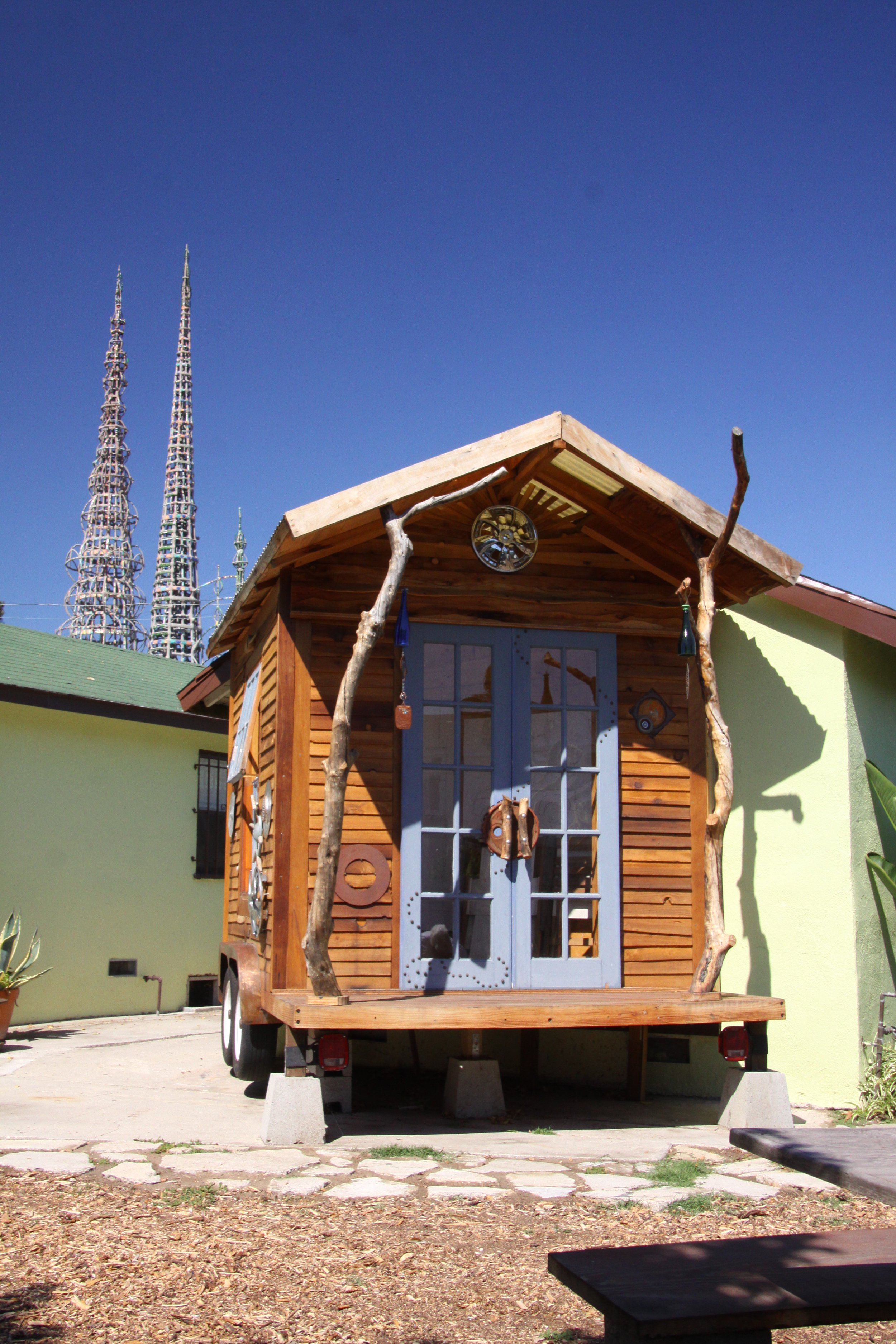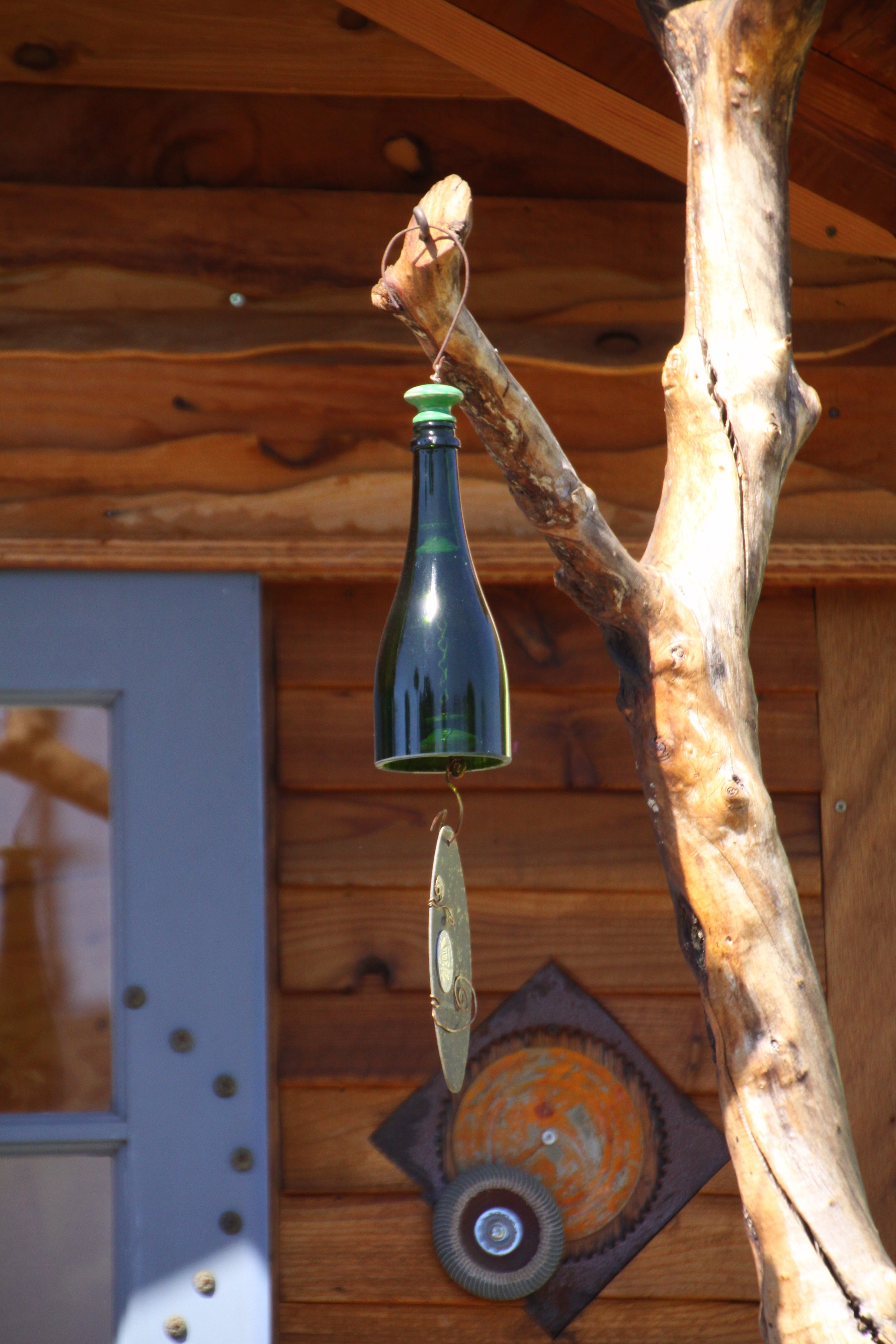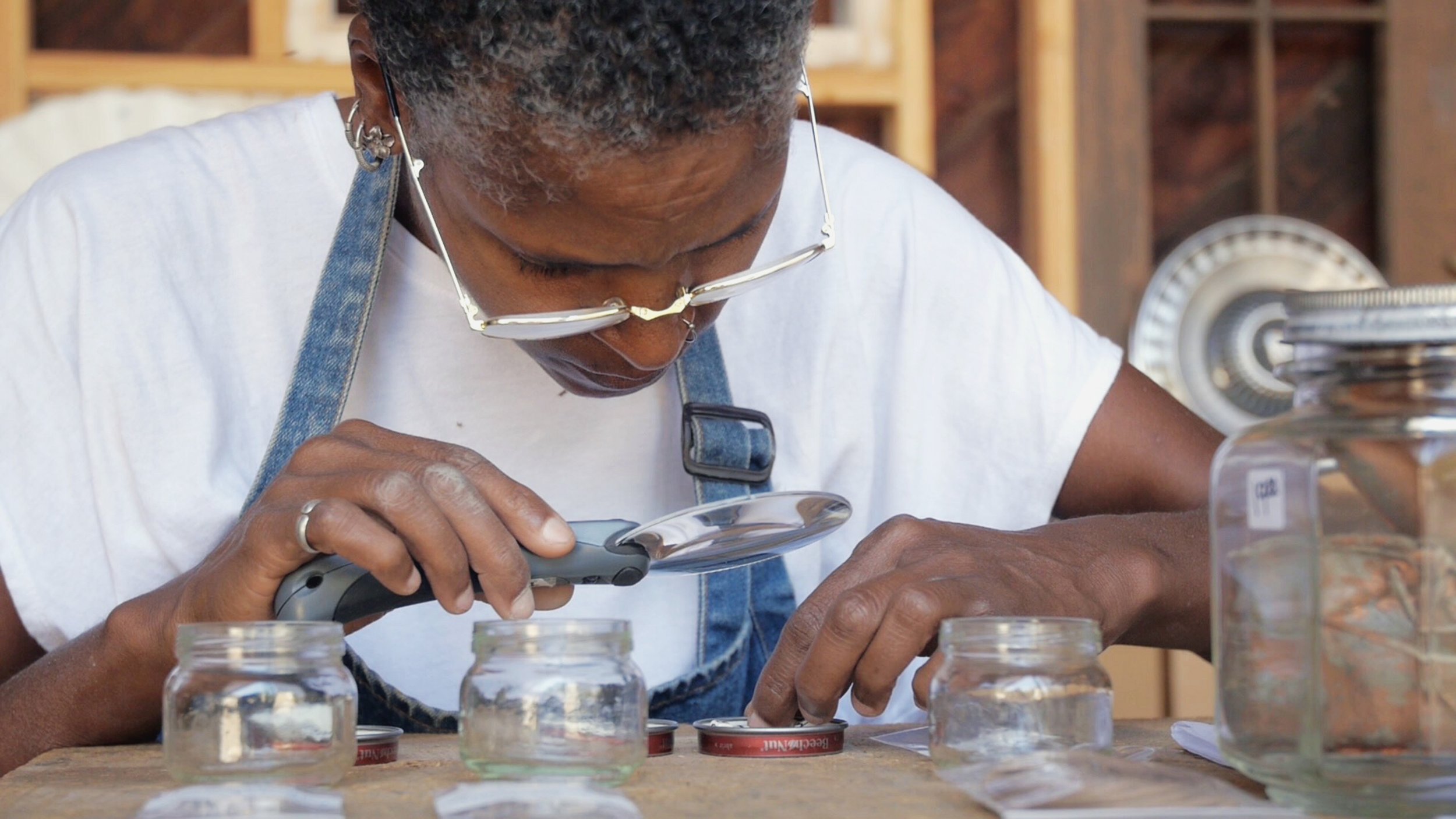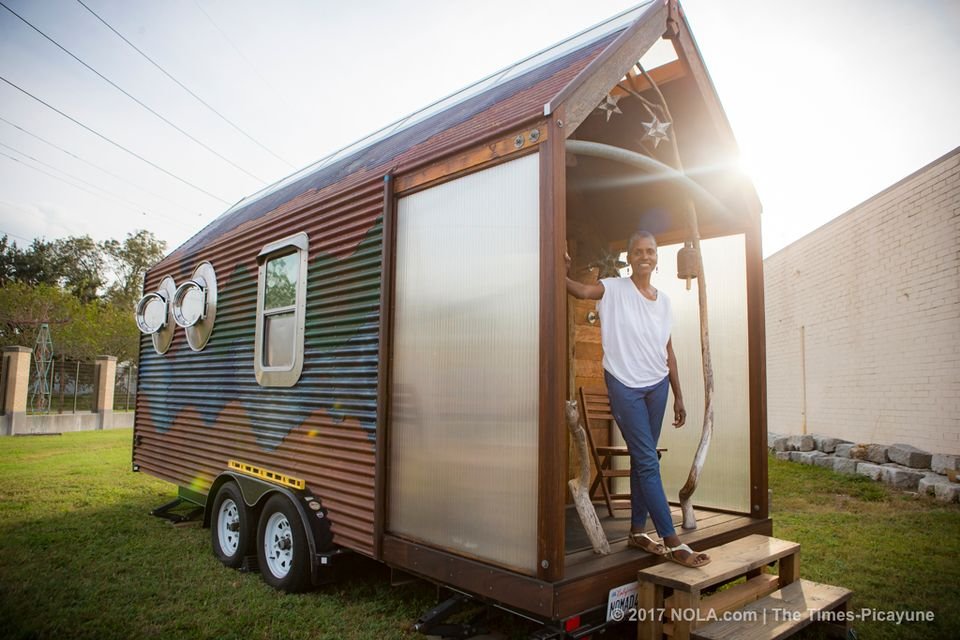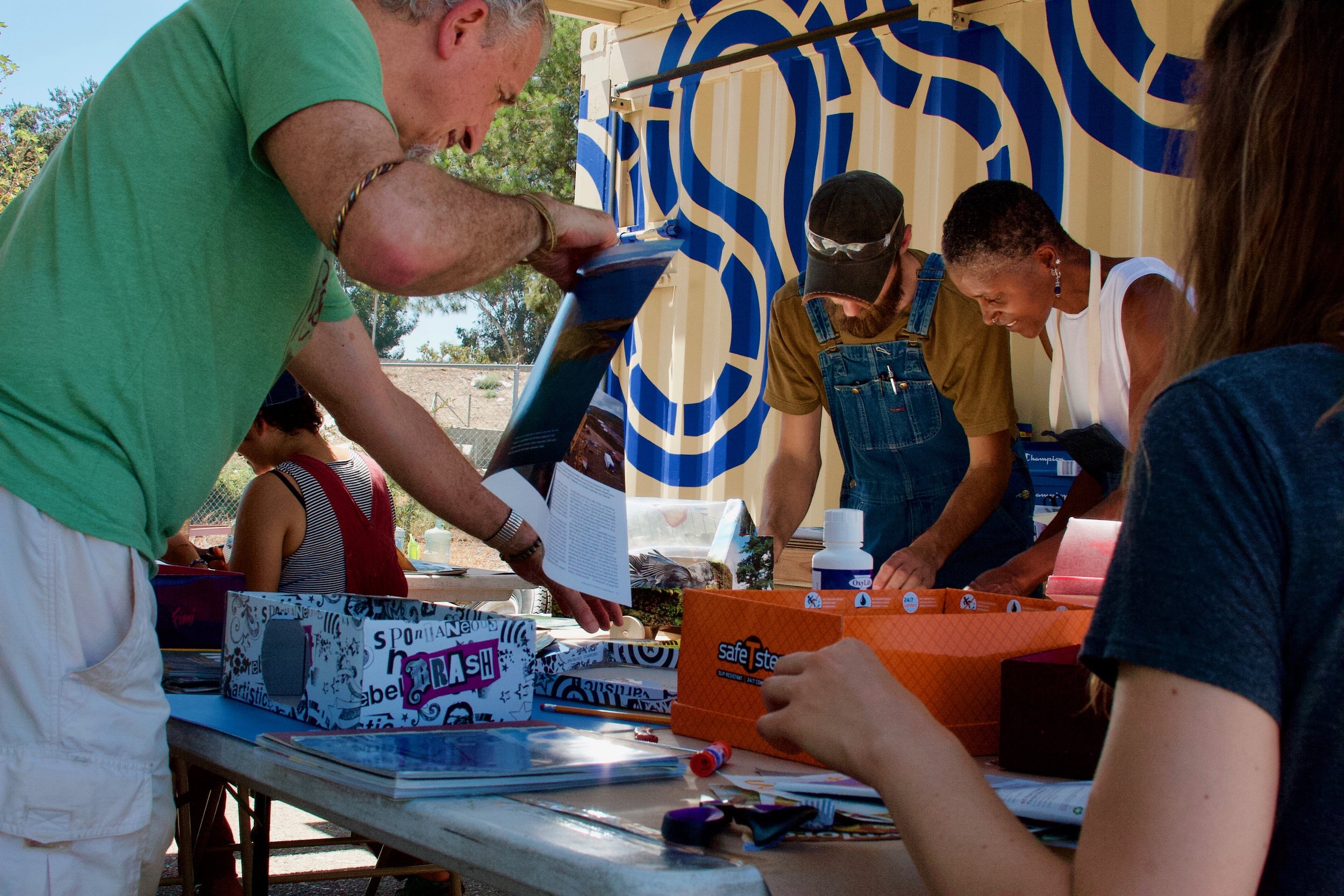R. Cloud House, Watts, CA
For this Artist Residency, I collaborated with property owner Janine Watkins and Rosie Lee Hooks, Director of The Watts Towers Arts Center. In addition to the residency, we collaborated on programming and exhibitions.
-
2011
10’ W x 111/2’ H x 7’ D
Assemblage installation. Salvaged windows and doors, SIP panels, plywood, salvaged fiberglass, found objects, tree branches and metal.
The CAAM installation was gifted by me to the R Cloud House Artist Residency in Watts. I collaborated
with property owner Janine Watkins and Rosie Lee Hooks, Director of The Watts Towers Arts Center. In
addition to the residency, we collaborated on programming and exhibitions.As I worked towards fulfilling my dream of the Nomad, I transformed what was once a vacant property into an active artist residence. I created a fully functional space to live, a working studio, and an edible garden.
Photo credit: Willie Middlebrook
Zorthian Ranch, Altadena, CA
From the urban neighborhood of Watts to the foothills of Altadena bordering Angeles National Park, the NOMAD took a journey as a work in progress.
-
2012–2015
From the urban neighborhood of Watts to the foothills of Altadena bordering Angeles National Park, the NOMAD took a journey as a work in progress. The late assemblage artist John Outterbridge introduced me to the architect Alan Zorthian, who welcomed a residency at his family’s 40-acre ranch. The building process required me to traverse between my sponsors of the raw materials at family-owned Anawalt Lumber in Montrose, and the ranch. I was introduced to Bill and Sasha Anawalt through the late Lyn Kienholz, all three of whom were art patrons. Their eager support played a significant role during my time there. The three-year build project set in this natural, almost wild environment was reflected in the found materials that I used for the NOMAD.
-
2014
Approx. 240" h x 180" w x 8" d
Reclaimed redwood, found objects, tempered glass.
The concept for “A Healing Home” evolved from a process that I explored using transparent collage on glass panes. These panes were then framed by windows and doors and embellished with found objects that created a narrative portrait of a particular place. Telling the story of a place is very much like telling the story of a person. I listen and hear the tales, but mostly I’ve learned to read between the lines of our complex lives that are enriched by universal contradictions of struggle and achievement.
My inspiration comes from materials that I intuitively assemble into visual narratives. Initially the doors and windows were composed as individual figurative forms. But as the concept evolved, it took the shape of a house wall under construction. That became a beautiful metaphor for the surrounding MLK community as a place that is the collective home for healing. A search through the hospital’s archival photos added historical details and a diverse cultural perspective. Although I had no idea what I would find, I was delighted to discover images like the unknown family of the first baby born at the hospital, and honored guests like Rosa Parks and Ray Charles. Through collage, these known and unknown individuals added to the rich history of the hospital’s forty plus years of service to the South Los Angeles-Wilmington community.
Collaging these images onto glass required a new method of digital printing to achieve both the aesthetics and durability that were needed. Objects added to these images brought a heightened sense of depth to the composition and created a vision that could inspire the viewer’s own memory and connection. Taken together, the piece evokes a healthy contemplation in the midst of what can often be an anxious waiting experience in a hospital.
Once I had a concept in mind, I needed to find my materials. Some things like the windows and doors came from my studio, many of which were found in and around the South Central area. The photos were edited from the archives from MLK and many of the objects were harvested from the Zorthian Ranch in Altadena where the artwork was assembled at The Z Ranch Studios. A few items, like the baby shoes and the scooter, came from flea markets. The wood is known as Clear Heart, a deep reddish brown and beautifully grained redwood. To find the quality of wood that also had the history and integrity of the found objects, I sought local reclaimed wood sources. This reclaimed redwood originally came from a dismantled 150-year-old bridge in Bakersfield, CA. A single beam allowed me to acquire all the re-milled pieces you see In the artwork. The timber company has dated the redwood at approximately 1,500 years old!! So it is from a tree that has lived many lives.
I have always been drawn to architectural forms, especially from the everyday dwellings that we live in and call home. These spaces are filled with memories and the relics of people who’ve inhabited them. Though sometimes seen as just the discards of our consumption, once cleaned and assembled into the harmony of a story, they become beautiful symbols. For example, the variety of circles and wheels displayed speak to the idea of mobility but also to the cycles of life. Aesthetically, their patina of rust, the aged paint and the darkened wood expose many ages of functional use. I also find that the contrast between materials is an essential visual contradiction where the rust and the shine of chrome together create harmony.“A Healing Home ” is the call and you the viewer are the response. I welcome all of you to share your memories and stories with us. That is what truly brings this artwork to life.
California African American Museum, Los Angeles, CA
NOMAD Artist in Residence 5-day mini-residency at CAAM, offering public tours, artist talks, and a master class in assemblage sculpture.
-
2015
8.6’ w x 12.6’ h x total combined length 44’
1950 truck, trailer, found objects, plexiglass
The NOMAD (Narrative, Odyssey, Manifesting, Artistic, Dreams) is an Art Truck and Trailer Dwelling which functions as a Mobile Artist in Residence.
I was invited by the former museum curator Mar Hollingsworth as an overnight guest in the Nomad, on the south lawn of the museum campus. During that week I offered public tours, artist talks, and a master class in assemblage sculpture.
The NOMAD was also featured in a KCET segment of “Artbound” that highlighted it’s story and journey. Placed in public view this residency attracted many students who walked through Exposition Park on their way to school, the museums or USC daily and were delighted by this unexpected encounter that sparked their imagination.
I’ve had more than a 25 year history with the California African American Museum. The early concept installation of the NOMAD had been exhibited there years before the residency. And most recently in 2020 the NOMAD returned in the midst of the pandemic, after it was vandalized outside the city, to protect it, the museum offered storage at the museum. Moving forward our shared journey will continue as we prepare for a retrospect exhibition in 2025.
Photo credit: KCET Nic Cha Kim.
Harrison House Music, Arts and Ecology, Joshua Tree, CA
This site-specific land work was inspired by my maiden voyage to Noah Purifoy’s Art Park in Joshua Tree, where I marveled at its raw beauty and paid homage to both Purifoy and Lou Harrison's 100th anniversaries. The garden is privately owned by Harrison House of Music, Arts and Ecology, but offers the site for public meditation events and musical performances.
-
2016–2017
100 ft long entrance.
Glass bottles and unearthed rocks.
Nomad Artist Residency in Joshua Tree CA
“Rocks and Bottles...” is a land corridor installation that encircles a Joshua Tree located at HHMAE as you enter the 100-foot-long, approximately 40-foot-wide passageway to the “Three Sistahs Dreamin’...” Garden. Unlike working in a studio, I had to be more attune with the environment, staying aware of the hot climate and hours of daylight. With the support of other residents and volunteers, I was able to face these challenges while meticulously cleaning bottles and excavating rocks to create the artwork.
During my stay there, I witnessed the growing migration of people from urban areas like LA coming to Joshua Tree. They were drawn, as I was, to its unique natural beauty and creative culture.
Photos by Dominique Moody
-
2016–2017
25’ diameter.
Glass bottles and salvaged wood found at site.
Nomad Artist Residency in Joshua Tree CA
Harrison House of Music, Arts and Ecology, 2016–2018.
I was invited to this residency by the founder Eva Soltes as the first visual artist. During my first tour of the site, I was drawn to an abandoned circular horse corral. It was an unusual sight to encounter, with the structure’s weathered wood and surrounding desert landscape. When I was shown piles of bottles and a set of arched wood templates on the property that had formed the historic straw bale house, I knew that this residency was a good fit for the Nomad.
With the context of my new environment in mind, I created a collaborative desert garden encircled by my sculptural fence. The fence was built using the salvaged glass bottles and wood construction panels, all found at the site.
Xavier University, John Scott Art Village, Prospect 4 Satellite Exhibition New Orleans, LA
This was the NOMAD’s first sponsored cross-country trip in which the trailer was hitched to a rental truck and towed, creating its first major journey on the road.
-
2017
The NOMAD was invited by Ron Bechet and MaPo Kinnord from Xavier University’s art department to participate in the Prospect 4 Satellite Exhibition, The Lotus in Spite of the Swamp in 2017. Actress and arts patron/collector C.C.H. Pounder sponsored the Nomad’s journey to New Orleans and back. These collaborative efforts made this 6-month residency possible.
The NOMAD was placed on the grounds of the Art Department on the XULA campus along with other temporary and permanent sculptures. Their exhibit gallery showcased my collaboration with students from the photography department. The exhibit was titled “Home”, which featured my sculptures alongside their photographs of New Orleans and their communities post-Katrina. The NOMAD was created to give homage to the traditional rowhouses (shotgun houses) of New Orleans that have their origins in African architecture. For this Artist Residency, in addition to the exhibit, I gave tours, talks, and media interviews. I also worked with local non-profit organizations that focus on housing.
Photo Credits: The Times Picayune
Side Street Projects, Our Garden of Dreams, Pasadena, CA
This project created a community garden that can grow food even for those who don’t have access to land. The completed functional greenhouse now offers workshops on growing edibles from pots in small spaces.
-
2018
I was invited to collaborate on a unique mobile structure by Emily Hopkins, Founder/Director of Side Street Projects, a mobile artist-driven nonprofit organization in Pasadena. They offer free woodworking experiences to the community through artist-led educational programs. My Nomad mobile dwelling was the inspiration for this project; together with the participants, we created a small mobile greenhouse using old windows and doors found on the streets and homes of their neighborhood. The SSP home base was located at John Muir High School, where the students participated monthly. Each week there were free workshops for the community on how to repair and repurpose wood windows into creative objects.
The name “Our Garden of Dreams” was formulated by the community members involved. Many had dreamt of an accessible, affordable garden that didn’t exist for low-income households. This project created a community garden that can grow food even for those who don’t have access to land. The silhouette mural was created from the photos of children who participated alongside their parents.
Photo credit: Max Gledman
